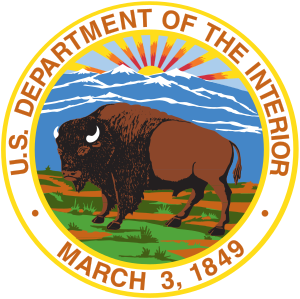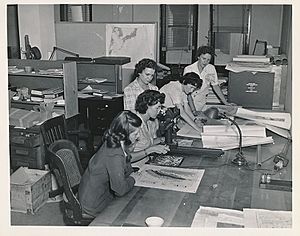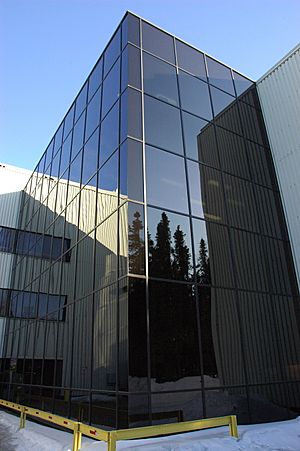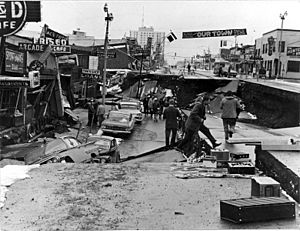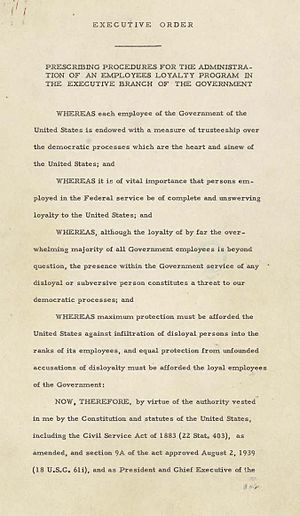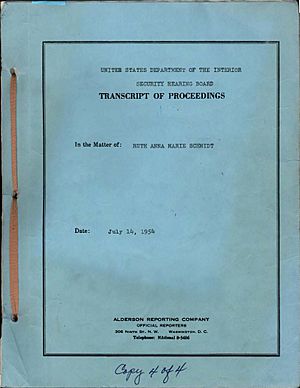Ruth A. M. Schmidt facts for kids
Quick facts for kids
Ruth A. M. Schmidt
|
|
|---|---|
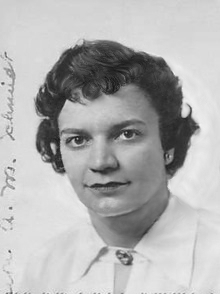 |
|
| Born | April 22, 1916 |
| Died | March 29, 2014 (aged 97) |
| Nationality | American |
| Education | |
| Scientific career | |
| Fields | |
| Institutions | United States Geological Survey |
Ruth Anna Marie Schmidt (April 22, 1916 – March 29, 2014) was an American geologist and paleontologist. She was a true trailblazer for women in science. Ruth spent most of her career in Alaska. There, she helped start a field office for the United States Geological Survey (USGS). She also created the first Geology Department at the Anchorage Community College, which is now part of the University of Alaska Anchorage.
In 1964, Ruth Schmidt led the first team to figure out how much damage the Great Alaska Earthquake caused in Anchorage. This was the biggest earthquake in North American history! Earlier in her career, she worked for the USGS in Washington, D.C. During a time called McCarthyism, she was unfairly investigated twice. This happened because she belonged to a bookshop that welcomed people of all races. She was found innocent both times. Ruth earned many awards and honors throughout her life. After she passed away in 2014, people also remembered her as a kind person who gave a lot of money to good causes.
Contents
Early Life and Learning
Ruth Schmidt was born in Brooklyn, New York, in 1916. She went to Erasmus Hall High School in Brooklyn. Then, she attended New York University from 1932 to 1936. This was during the Great Depression, a very tough economic time. She was an excellent student and earned her bachelor's degree in geology in 1936. Ruth's family really encouraged all their children to go to college. All her siblings, including three sisters and one brother, also earned college degrees.
While in college, Ruth joined a special group called Phi Omega Pi. She also won the Most Valuable Player award for hockey! The school newspaper even wrote that she was "crazy about fossils."
After college, she studied different sciences like biology and inorganic chemistry. She also learned how to use X-rays to study things. To save money for graduate school, she worked as an X-ray technician. She even took X-rays of animal bones and shells at the American Museum of Natural History. Ruth won a special scholarship to study how X-rays could help in paleontology, which is the study of fossils. She started her advanced studies at Columbia University in 1938. She earned her master's degree in 1939. Her main project was about tiny fossil creatures called "Ostracoda" found in the Yorktown Formation. She finished her highest degree, a doctorate in geology, in 1948.
Her Career as a Geologist
Ruth Schmidt was a true pioneer for women in science throughout her career. When World War II started, many male students went to serve in the military. Because there weren't enough teachers, Columbia University asked Ruth to be an assistant. She was the first female graduate student to teach classes made up only of men at Columbia! She taught science and how to make military maps.
Ruth also cared a lot about civil rights for all people. When she lived in Washington, D.C., she joined the Washington Cooperative Bookshop. This bookshop believed in treating everyone equally, no matter their race. But during a time called McCarthyism, the government unfairly labeled this bookshop as "communist." Because of her membership, Ruth was investigated twice by the government. Luckily, she was found innocent both times.
Ruth traveled all over the world as a geologist. Her passports show stamps from many countries, including Argentina, Australia, Japan, and the United Kingdom. She also traveled a lot across the United States and especially throughout Alaska. She even crossed the Arctic Circle many times!
Working for the USGS
Ruth Schmidt started working for the United States Geological Survey (USGS) in Washington, D.C., in early 1943. She worked for the USGS in different roles until 1963. From 1946 to 1948, she studied fossils and used X-rays for the USGS.
From 1948 to 1950, Ruth worked for a top-secret part of the USGS called the Military Geology Unit. She helped prepare secret reports for the military about building roads, airfields, and finding construction materials in Europe and the Pacific. She was one of the few women geologists hired for this important and secret work.
From 1950 to 1952, Ruth helped organize map names and fossil maps for the USGS. Then, from 1952 until she moved to Alaska in 1956, she helped catalog minerals found on all U.S. federal lands. In 1956, Ruth moved to Anchorage, Alaska. There, she opened a new USGS office. She was in charge of all technical and administrative work related to classifying federal lands for oil, gas, coal, and other minerals.
By 1961, Ruth wasn't happy with just office work. She asked to transfer to a research role so she could do more geology fieldwork. However, her request was turned down. She was told that the USGS was looking for "hearty new male PhD's" for research roles.
In 1963, after 20 years, Ruth left the USGS. She didn't want to leave Alaska, where she had bought a home and a small cabin. She had also become very involved in the local community. She even helped start the Alaska Geological Society in 1957–58 and was its first president.
Teaching at the University of Alaska Anchorage
Ruth Schmidt started teaching part-time in 1959 at the Anchorage Community College. This college later became part of the University of Alaska Anchorage (UAA) in 1962. She was the very first geology professor at the university. For a while, she was the only geologist there! Women geologists were very rare back then, so Ruth was truly a pioneer.
She started the Department of Geology and was its first leader. In 1970, she designed and oversaw the building of the geology laboratory. She was known as a great teacher and became an associate professor in 1970. She taught many subjects, including geology, environmental education, and paleontology. She also advised students and helped create new courses. She worked at UAA for 25 years until she retired from teaching in 1984.
In 1964, Ruth and four other people were on the frozen Portage Lake when the huge Great Alaska Earthquake hit. After a scary experience getting off the shaking ice, she was chosen to lead a group of 50 scientists. Their job was to figure out the damage in Anchorage before the city could be rebuilt.
The Great Alaska Earthquake
The Great Alaska Earthquake was the strongest earthquake ever recorded in North America. It was the second strongest in all of history! It hit Alaska around 5:30 p.m. on March 27, 1964, and measured a huge 9.2 on the scale. The damage was immense. A giant tsunami (a huge ocean wave) followed, destroying towns along the coast from Alaska to northern California. Landslides wiped out neighborhoods, roads and train tracks were ruined, and important services like gas, electricity, and phones were destroyed. The USGS believes 143 people died, and thousands lost their homes. The damage cost about $2.3 billion in today's money.
On the day of the earthquake, Ruth Schmidt was leading a research team on Portage Lake. This was a frozen lake near Anchorage. The team was drilling holes in the three feet of ice to measure water depth and study how dirt settled. They had just finished a hole when the earthquake struck. The water under the ice sloshed back and forth, making the ice move five feet! Loud booming sounds followed the earthquake, which lasted for almost five minutes. The team saw avalanches on the mountains around the lake, and the flying snow made it hard to see.
Ruth led her group to try and get off the ice. But cracks and open water made it impossible. They left their snowmobile and started walking in a different direction. They tied themselves together with a rope in case someone fell into a crack. Once they reached shore, they found a cabin and were able to contact help by radio. The next day, a helicopter rescued them. Ruth and others immediately began working to figure out the earthquake's impact.
Ruth Schmidt was chosen to be the main coordinator for the Engineering and Geological Evaluation Group. She led a team of 50 scientists to assess the damage and suggest how to rebuild Anchorage. At first, the state government, not the federal government, sponsored this group. The scientists included geologists, soil scientists, and engineers.
There were some disagreements between Ruth's scientific group and the business leaders in Anchorage. Business owners wanted to rebuild quickly. But Ruth and the scientists wanted to carefully study the damage and understand future risks. Despite the pressure, Ruth's group finished their study and published their final report on May 8, 1964, about a month after the earthquake.
Ruth later donated all the documents related to this important report to the University of Alaska Anchorage archives.
Consulting Work
On January 1, 1964, Ruth Schmidt started her own geology consulting business from her home in Anchorage. She prepared reports on oil wells, building sites, and road construction for her clients. It was in this role that she led the team studying the effects of the Great Alaska Earthquake. The Governor of Alaska, William A. Egan, even wrote her a letter thanking her for her "dedication and foresightedness" on this project.
From 1974 to 1975, she worked as an environmental consultant for the Governor of Alaska. Her job was to check on the building of the Trans-Alaska Pipeline System (TAPS). She traveled along the pipeline to inspect its environmental effects and how work camps were managed. Governor Jay Hammond gave her a special award in 1977 for her service during the pipeline's construction.
Loyalty Investigations
During the McCarthy era, Ruth Schmidt was investigated twice. This was because the government thought she might be disloyal to the U.S. government. The main reason was her involvement with the Washington Cooperative Bookshop. This store in Washington, D.C., sold books, records, and art. It was special because it supported racial equality between African Americans and white people. This was at a time when Washington was largely segregated. The bookshop sold books about African American topics and hosted events for people of all races.
In 1947, the U.S. Attorney General, Tom C. Clark, made a list of organizations he called "subversive" or "communist." This list was made public in the Washington Post. The Washington Cooperative Bookshop was on this list, labeled as "Communistic." The government claimed it sold communist books and hosted speakers thought to be communist. This list was created after President Harry Truman issued an order to check the loyalty of all federal employees. The organizations on the list were not allowed to see the evidence against them or defend themselves.
1950 Hearing
In 1947, Ruth had a routine loyalty check and was cleared in 1949. But in 1950, her membership in the Washington Cooperative Bookshop came up again. She was officially accused of disloyalty in a letter dated August 15, 1950. Even though the bookshop had closed, Ruth still had to answer for her past membership.
Ruth hired a lawyer to help her. She also wrote to her former professors, friends, and co-workers. She asked them to write sworn statements saying she was honest and loyal to the U.S. government. Many people wrote letters supporting her. Her geology professor from Columbia University wrote that she was "always devoted to her science, geology, and as far as I have been aware not been interested in anything else."
Ruth had a three-hour hearing on October 25, 1950. She admitted that she had been a member of the Washington Bookshop Association. On January 15, 1951, the Secretary of the Interior Department sent Ruth a letter. It stated that "no reasonable ground exists for believing that you are disloyal to the Government of the United States." She was cleared!
1954 Hearing
In 1954, Ruth received another letter saying she was being investigated again. This time, she was accused of being a member of a "totalitarian organization" (meaning the bookshop) and being friends with 21 people suspected of being communists. Ruth hired her lawyer again. In her written response, she explained her connection to the bookshop and to the people mentioned. She said she knew some as casual acquaintances and others as social friends. Some she didn't even remember.
The Department of Interior decided her explanations were not enough. So, they granted her another hearing, which was scheduled for July 14, 1954.
Once again, Ruth was cleared of all the charges.
Awards and Honors
Ruth Schmidt received many awards, honors, and thank-you letters for her hard work, loyalty, and achievements. Here are some of them:
- Alaska Audubon: Awards for her dedication to conservation and service.
- Alaska Center for the Environment: Honored for her work in Alaskan conservation.
- Alaska State Parks Volunteer Service Award.
- American Association for the Advancement of Science (AAAS): Elected as a Fellow.
- American Association of Petroleum Geologists: Certificates for many years of membership.
- American Civil Liberties Union (ACLU), Anchorage Chapter: Special Certificate of Recognition.
- American Institute of Professional Geologists (AIPG): Certificates for many years of service.
- Arctic Institute of North America: Elected as a Fellow and given a life member certificate.
- Common Cause: Certificate of appreciation.
- Department of the Interior, United States Geological Survey Service Award: For 20 years of government service.
- Geological Society of America (GSA): Elected as a Fellow and recognized for 50 years as a Fellow.
- International Geological Congress: Certificate of Appreciation for her great contributions.
- President Bill Clinton: A thank-you letter for her participation in discussions about women's issues.
- Public Citizen: Certificate of Recognition.
- Society for Sedimentary Geology (SEPM): Certificates for 60 and 65 years of membership.
- State of Alaska Commendation: For her work on the Trans Alaska Oil Pipeline, signed by Governor Jay Hammond.
- The Living Room Floor Map and Debating Society: Recognized her as a founding member of a group that worked to protect Alaskan lands.
- Who's Who of American Women and Who's Who in Frontier Science and Technology: Included in these important lists.
Later Life and Legacy
Ruth Schmidt retired from teaching in 1984 after 25 years. She continued to work as a geology consultant until 2000. She passed away at the age of 97 on March 29, 2014.
Ruth was a philanthropist, meaning she gave a lot of money to good causes. In her will, she donated significant funds to 22 charities, mostly in Alaska. She created the Schmidt Charitable Trust, named after her parents. This trust helps Alaskan students who study earth sciences, especially Alaska Native students and other minorities. She regularly donated to groups like the American Civil Liberties Union, the Audubon Society, and conservation groups. She also gave to Common Cause and Public Citizen, which are groups that work for democracy and public interest. In 1998, she secretly donated $10,000 to the Alaska Museum of Natural History.
In 1960, Ruth bought 4.8 acres of wetland outside Anchorage for $2,000. By 2012, this land was worth almost $300,000! She donated it to a land trust, which then gave it to the Municipality of Anchorage Parks and Recreation Department.
Ruth Schmidt was a true pioneer for women in science. She was a wonderful mentor, role model, and colleague for her students. She is recognized for creating the "foundation of the geoscience curriculum" at the University of Alaska Anchorage. In 2015, after her death, she was inducted into the Alaska Women's Hall of Fame.
External Resources
- Who was Ruth Schmidt? UAA/APU Archives—Omeka
- Ruth A. M. Schmidt curriculum vitae (resume) UAA/APU Archives—Omeka
- Photographs of Ruth A. M. Schmidt UAA/APU Archives—Omeka
- Objects Schmidt used in her work as a geologist UAA/APU Archives—Omeka
- Ruth Schmidt obituary. Legacy.com
- 1964 Alaska Earthquake damage photos. USGS.
- The 1964 Great Alaska Earthquake and Tsunamis—A Modern Perspective and Enduring Legacies
- Prelude to McCarthyism: The Making of a Blacklist, Prologue Magazine, National Archives
- Executive Order 9835, Executive Orders Harry S. Truman, Harry S. Truman Presidential Library & Museum
- Executive Order 10450, Federal Register of the National Archives



